Crocheting is a hobby that consists of winding yarn around two small sticks called hooks formed by metal wire with a hook at one end. A crochet hook has many different sizes, and the average crochet hook is about 7 inches long. There are three kinds of stitches: single stitch, double stitch, and treble stitch. When you make all three stitches, it’s called “crochet”. Each stitch will form a new layer on top of the previous one to create an object. To become an experienced crocheter, you need some tools and materials. So here is a list of what you need to start crocheting.
Check these beginner crochet kits. If you’re just getting started with crocheting, In my opinion, they’re great to get started as you don’t need to go all over the place to buy individual tools and materials.
What do you need for beginner crochet?
Yarn ball winder
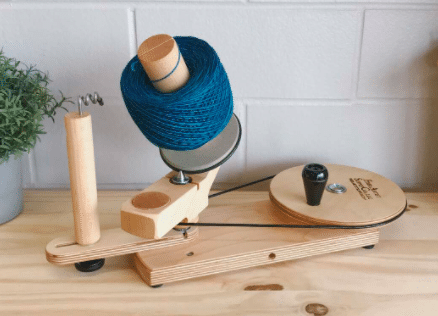
Yarn ball winder is an essential tool for anyone who crochets or knits yet requires little space. A suitable yarn ball winder should be compact and lightweight, with a large capacity. The double-ball provides the option to make one larger ball of yarn quickly; simply pull out any length you want to use, then push the rest back in. This item comes ready to use right out of the box with no setup required. Simply thread your yarn into the eyelet on top and start turning the handle to create your very own center-pull balls perfectly sized for your project! You can control how tightly the wound your yarn is and how much tension is around the skein to make it easier to remove the yarn from the ball without pulling and breaking it.
The Yarn Ball Winder solves many problems for crocheters and knitters.
-It saves time and effort usually spent winding a skein into a ball by hand (which generally results in tangles, knots, and breaks). It is also much faster than using a simple yarn swift that requires either using one’s arms as the swift or relying on an object that can easily fall over.
-It helps you save money by preventing loose ends of individual skeins from tangling with other supplies.
-It takes up little space, so you’re able to store it in your project bag and take it with you wherever you go.
-It provides consistent, center-pull balls of yarn that are great for knitting or crocheting projects. It ensures that the first stitch is never too tight or too loose; all other stitches will also be uniform.
Yarn ball winders save time, money, storage space and provide more even tensioned yarn for crochet and knitwork. No person who crochets or knits should be without one!
Measuring tape or ruler
Measurement tape comes in handy when you don’t have a gauge swatch. Just hang the tape measure around your neck, and everything will be fine! Sometimes the listed gauge isn’t entirely accurate, and using the measuring tape can help solve that problem. Also, I find it helpful in measuring my work and checking my measurements against those of clothes/hats.
Gauge swatch (optional)
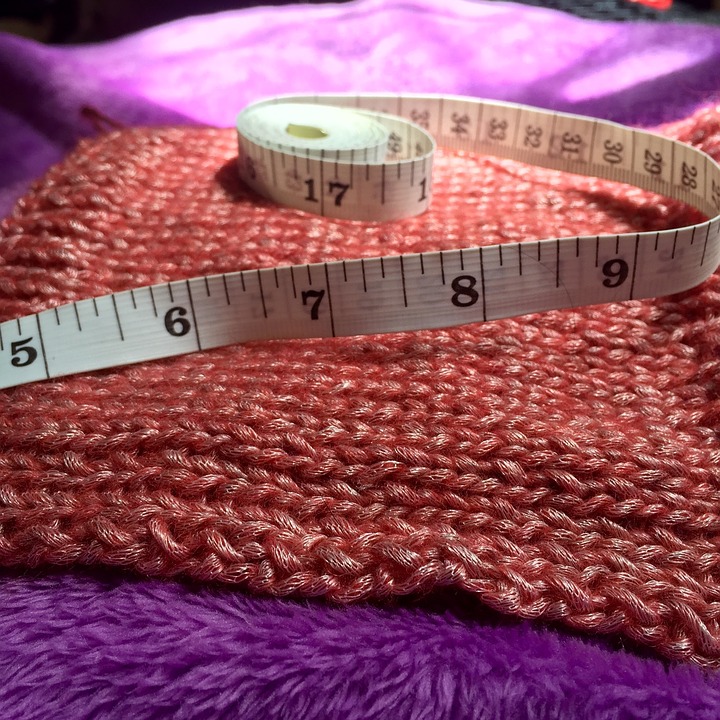
A gauge swatch is a sample piece of crocheted fabric used to determine a particular yarn or thread’s size, gauge, and/or texture when used as part of a project. For example, if someone wants to make a scarf from yarn that has been determined to have 20 stitches per 4 inches (10 cm), they might make a gauge swatch with their chosen hook size and compare its dimensions against the desired dimensions written in the pattern document. If their swatch’s dimensions are much smaller than those specified in the document, they will need to use a larger hook than they might typically expect. If the dimensions of their swatch match those specified in the document, but their stitches are too loose, they may either need to decrease their hook size or tighten up on their tension when making each stitch.
A gauge swatch is usually made on a smaller scale than an actual piece of crochet work, generally by working more rows and/or rounds per inch (2.5 cm) or centimeter on the small sample. It also uses fewer stitches, which allows for more accuracy on matching gauges, especially if working with yarns containing fibers like mohair or angora, which cause stitches to become distorted quickly.
Tapestry needles
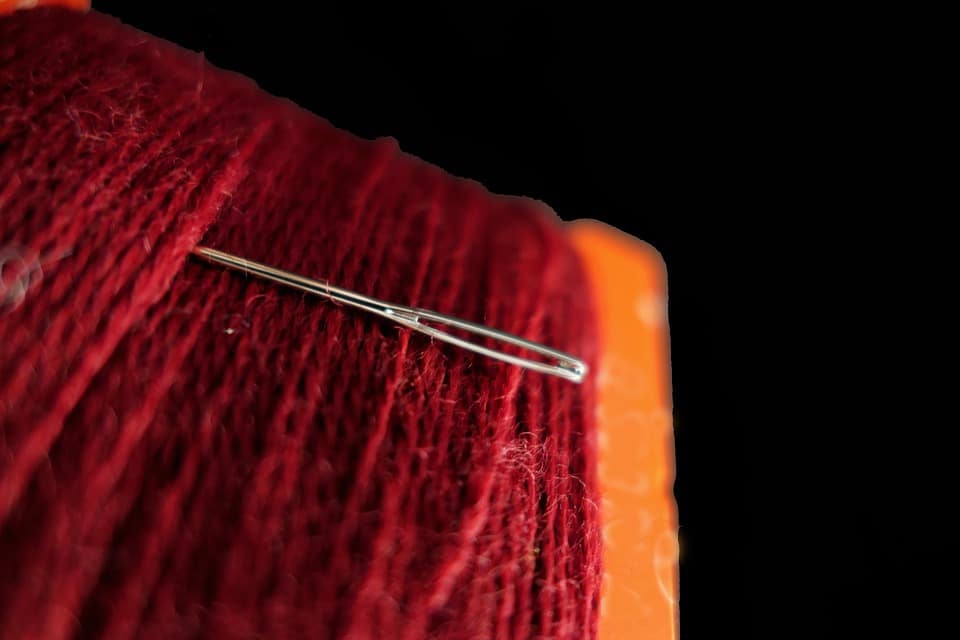
Tapestry needles are used to stitch two pieces of material together. They are also called tapestry or embroidery needles.
Tapestry needle sizes range from 0 (largest) to 7 (smallest). The larger the number, the smaller and finer the needle. You will want a size that matches your yarn weight. For example, use a size 5 for worsted weight yarn and a 2 or 3 for thread weight yarns.
An elongated eye is preferred because it easily slips through bulky knits fabric under the stitching line without snagging fabric fibers. Most tapestry needles have a sharp point which makes them easy to slip between stitches without too much blunt force trauma on the yarn fibers as you insert them.
Crocheters (and knitters) can also use tapestry needles for other purposes. For example, they are perfect for pulling a strand of loose yarn through your work when weaving in the ends. I have even used them to help control tension while I’m dropping down 12 loops at one time on double-ended crochet hooks.
Tapestry Needles are available in different materials, including plastic, steel, and bamboo.
Stitch markers
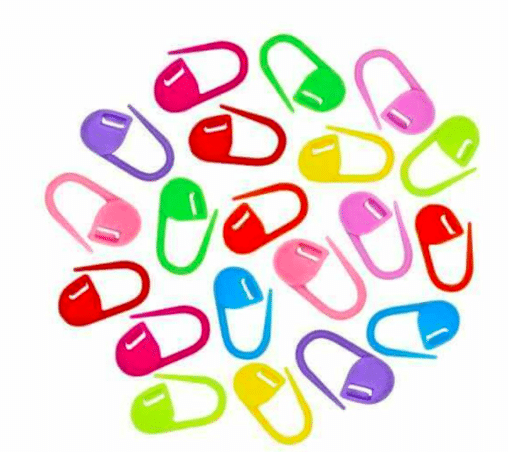
Stitch markers are essential tools for hand-crocheters. They mark stitches on the needle, show how far you have crocheted on a row, and indicate when to increase or decrease. Several types of stitch markers can be used in crochet work.
What are the different types of stitch markers for crochet?
4 ways to use stitch marker
Closed Ring Marker: A small ring with an opening that closes over one or two strands of yarn to mark a specific stitch or location in your work. This type of marker is typically used when you need/want to move it along as your work progresses. The opening and closing take just enough extra time to be annoying but not so much effort that it’s out of the question.
Loop markers: A small, usually vinyl or plastic ring that ties around your strand(s) of yarn for marking stitches in crochet work. This type is easy to slide up and down the yarn when you need/want to move it along as your work progresses. These are especially nice if you tend to make mistakes when counting because they allow you the freedom to pick the marker back up and start over without having to cut and re-attach your yarn in order to be ready for whatever it is you’re trying to do next.
Hook-type stitch markers: The most popular brand name for these types is Cro-Needles, which consist of either two or three hook-ended pieces that can be used singly or in a set to mark specified stitches. These are quick and easy to use, but not quite as small or versatile as the closed ring markers mentioned above. You can attach them anywhere along your yarn strand(s) and then slide them along into a different position – back toward the end you started crocheting at or forward to where you’re currently working. If you need/want to move these along (which is slower than using hook-type marker sets) you will also need to cut your yarn strand somewhere close by before picking up again with another piece of yarn.
Chain-type stitch markers: It consists of one crochet hook-ended piece that can be used singly or in a set to mark specified stitches. Attaching the marker is faster than using hook-type stitch markers but not quite as small or versatile. After connecting it you will still need to cut your yarn strand somewhere close by before picking it up with another piece of yarn.
Button stitch markers: I have several sets of these, and they are quick and easy to use – loop them around a strand of yarn and attach them wherever you want. They can be used singly for marking a single stitch or in a set for marking multiple stitches at once within a given area on your work. However, this method takes extra time because you have to stop crocheting every time you go from one marked stitch/area. You also may have problems if you need to use a set of these more than once for marking multiple stitches because the button gets pushed around.
Crochet hooks
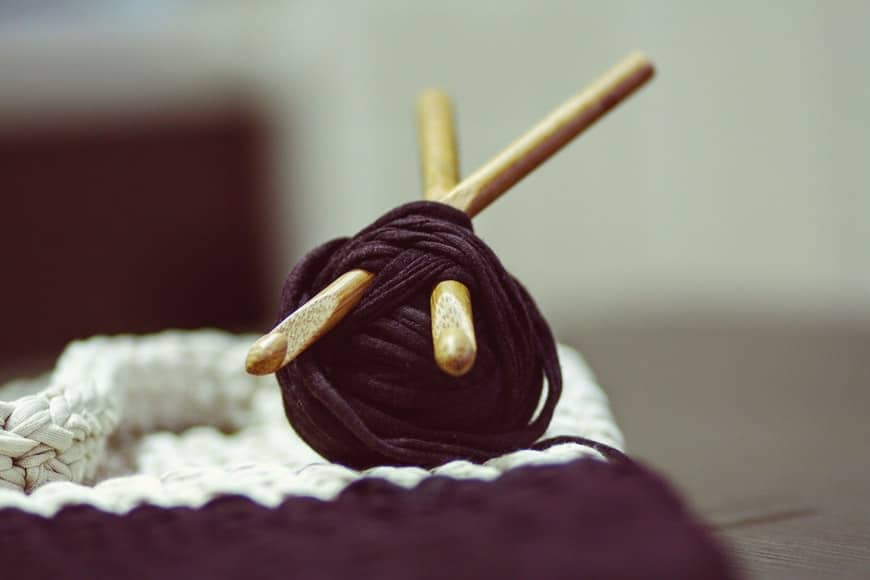
Crochet hooks come in a variety of sizes and materials, such as aluminum, wood, bone, plastic, and steel. They also come in all kinds of shapes and heads to accommodate the different stitches that need to be made with them. The crochet hook is used to pull loops through other loops creating the stitches needed for crocheting. An item being worked on can either be turned so that the right side faces out or it will have an inside and outside like a sock does where certain stitches face one way or another depending on which side is facing outward.
What’s important about different crochet hooks are the materials they are made from, how large they are so it’s easier to maintain control over your work, especially if you have problems with your hands or coordination, and how they feel. Everyone has their own personal preference on the hook that works best for them so it’s good to be able to try out various types of crochet hooks before you settle on one type.
My favorite crochet hook is made out of wood because I like to work slowly, and with a wooden crochet hook, I can almost go in slow motion, at least when compared with using lightweight plastic ones. The plastic ones are usually skinnier than the wooden ones, making it harder to control your stitches if you have small fingers like me, but once you get used to the smaller head of the lighter weight hook,s they become easier to use. you get comfortable doing more complicated stitches with them because you have more control.
If you choose metal hooks, it’s important to be careful because they’re much sharper than plastic ones, and if your yarn isn’t strong enough or you try to take stitches up too far it can cause your material to break or come loose from the stitching which can be frustrating.
Crochet hook sizes
In North America, the most popular crochet hook sizes range from G (4mm) to K-10½ (6.5mm), though you’ll commonly find an assortment of size 6 (4mm), 7 (4.5mm), 8 (5mm), 9 (5.5mm) and 10 (6mm) hooks available in most local stores.
Steel crochet hooks typically come in sizes from B1 (2.25mm) to size 1 or O (15mm). Although the head width of a steel crochet hook is typically no more than 1″/2cm, shaft lengths can vary from 2-8″/5 – 20cm long depending on the brand and hook type. The smaller steel crochet hooks work particularly well for thread crochet and miniature crochet projects when you want your stitches to be nice and neat without any gaps between them since their small diameter prevents your yarn from getting caught between stitches as easily as with larger gauge hooks. Aluminum crochet hooks are similar to steel crochet hooks in size and shape, though their lightweight quality makes them a bit more comfortable, especially when used to work with a larger gauge or thicker yarns.
Yarn
Choosing the right type of yarn for a project is essential to its success. Different types of yarn have other qualities and attributes which will affect your final crochet work. In some cases, you may choose a specific type of yarn for its effect on your end result – this could be anything from the feel of the fabric to how it drapes or how it glows in the light. However, in most cases, you will choose a type of yarn based on its weight.
The weight of yarn refers to how thick (or thin) the strand is. It affects the thickness of completed work. A thinner strand results in greater flexibility and less rigidity in your fabric; you can also use thinner yarn for finer details. Thicker strands produce tighter, more structured fabric; thicker yarns are better for large or bold designs.
Weighted categories of yarn
Yarn is generally grouped into nine weighted categories, which can be further divided by number to encompass a range of thicknesses. A list of the different weights and their corresponding numbers (and what they’re best used for) is given below. Suggestions are given as guides only; there will always be exceptions to these rules.
0 – Cobweb weight
1 – Fingering weight
2 – Sport weight
3- DK
4 – Ed
5 – Aran
6 – Worsted
7 – Chunky
8 – Super-bulky
9 – Super-chunky
These weights do not indicate that a yarn of one weight cannot be made from a yarn of another weight: for example, some worsted yarns can be thinner than some chunky yarns and so on.
F.A.Q.
Is it easier to learn to knit or crochet?
It is much more difficult to teach yourself how to knit than crochet. When you are crocheting, all you need is a basic knowledge of what the stitches should look like and how they should be formed. You can get instructions from books or online tutorials. Start practicing, and before you know it, you’ll be creating your own patterns and projects with ease! Crochet also requires less equipment than knitting: no needles are needed except for a small crochet hook in your choice of size. Besides that, all you need is yarn and something to tie off the ends when you’re done (such as a large knot).
Do you need two needles to crochet?
No, you don’t typically need two knitting needles to crochet. The difference between the two crafts is that a hook is used instead to create stitches from yarn in crochet. Instead of holding your yarn with one needle and throwing it over with the other, you hold one end of the yarn in your left hand and throw the rest over a small hooked tool in your right hand. Then, all you have to do is pull this tool through loops to form the stitches themselves. If making a row of double crochet stitches, for example, once finished, there will be three loops on your hook where there were originally only two before you started.
The post What do You Need to Crochet? appeared first on Art & Craft, DIY ideas and Tutorials - Craftbuds.
